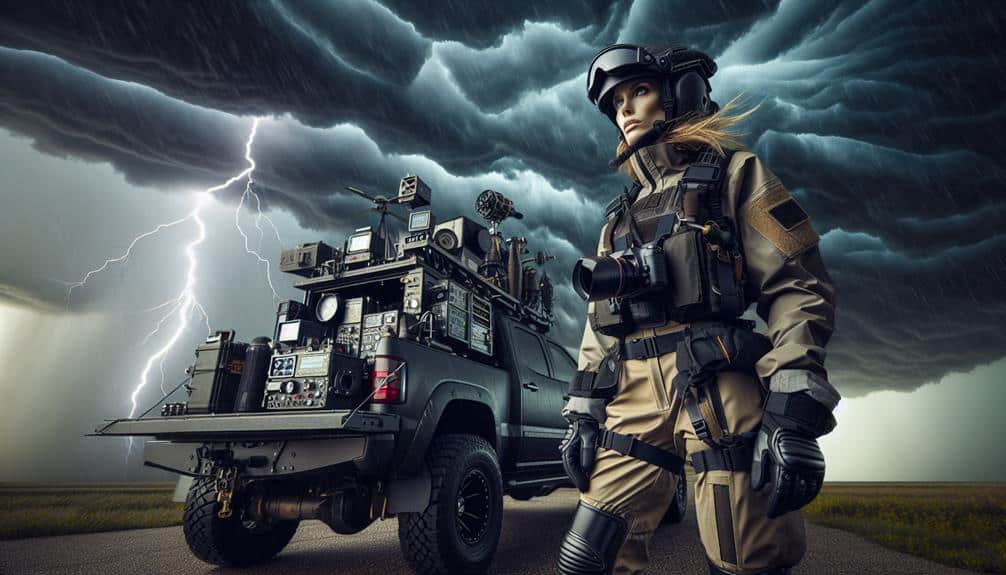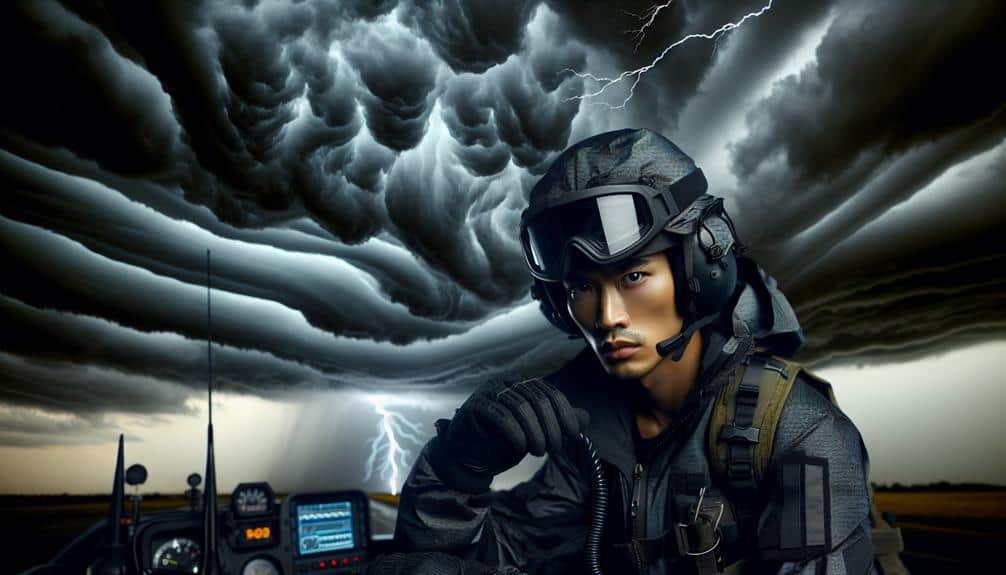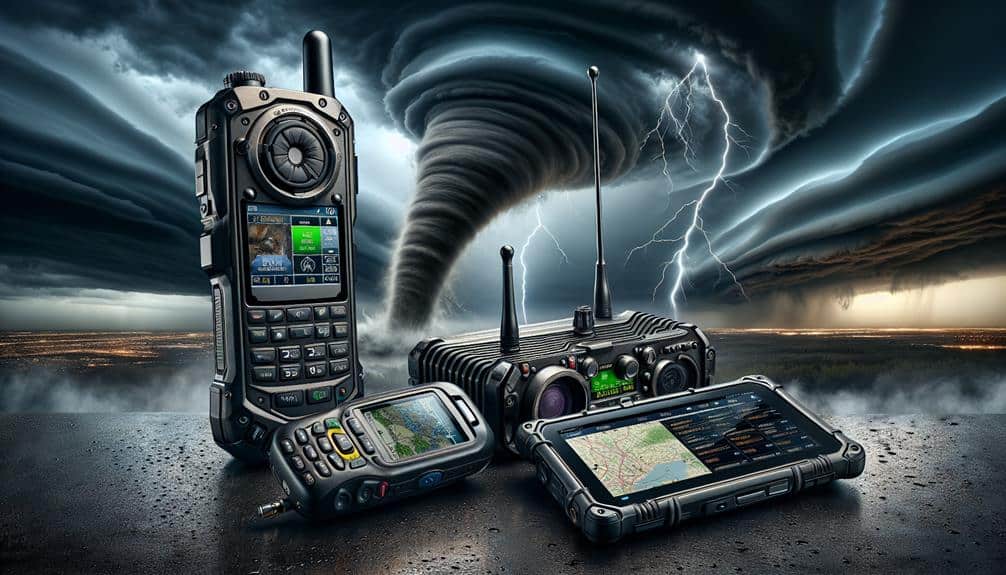When storm chasing, we must prioritize eyewear with impact-resistant lenses made from polycarbonate or Trivex to withstand hailstones and high-velocity projectiles. We'll choose lenses that offer 100% UV protection to shield our eyes from harmful rays. Ensuring a secure fit with adjustable features like nose pads and temple arms is essential to keep eyewear in place. Anti-fog coatings on lenses help maintain clear vision in varying conditions. Finally, we must select for comfort and durability, choosing lightweight, shatterproof, and scratch-resistant materials. These elements combined will prepare us for the most challenging weather while keeping our vision at its best and protected.
Key Points
- Choose polycarbonate or Trivex lenses for maximum impact resistance.
- Ensure 100% UV protection to safeguard eyes from harmful rays.
- Opt for adjustable nose pads and temple arms for a secure and comfortable fit.
- Select eyewear with anti-fog coatings and proper ventilation to maintain clear vision.
Choose Impact-Resistant Lenses
When choosing eyewear for storm chasing, we must prioritize impact-resistant lenses to guarantee maximum eye protection against flying debris. This choice isn't just about comfort; it's an essential safety measure.
Lenses made from polycarbonate or Trivex materials offer exceptional impact protection. These materials aren't only lightweight but also highly durable, making sure that our eyewear can withstand the harsh conditions we often encounter in the field.
Lens durability is another vital factor. We need eyewear that can endure sudden impacts from hailstones, shattered glass, or other high-velocity projectiles. ANSI Z87.1-certified lenses are a reliable option, as they've been tested rigorously for impact resistance. This certification assures us that the lenses can handle significant force without shattering, thereby protecting our eyes from potential injuries.
Furthermore, the design of the eyewear should include wraparound frames. These frames provide additional protection by covering peripheral vision areas, minimizing the risk of debris entering from the sides.
Opt for UV Protection
In addition to impact resistance, we must guarantee our eyewear provides strong UV protection to shield our eyes from harmful ultraviolet rays during storm chases. UV rays can cause significant damage to our eyes, leading to conditions such as cataracts and photokeratitis. By selecting eyewear with 100% UV protection, we minimize these risks and assure our vision remains unimpeded by glare or reflections.
When choosing eyewear, we should consider lens tint options. Different tints offer various levels of contrast and brightness management, important for adapting to changing light conditions during storm chases. For instance, gray lenses provide true color perception, while amber or brown lenses enhance contrast in low-light situations.
Another vital factor is deciding between polarized vs. non-polarized lenses. Polarized lenses reduce glare from reflective surfaces such as wet roads and water pools, enhancing visual clarity and reducing eye strain. However, they can make it difficult to read digital screens, which might be a consideration if we rely on electronic devices for navigation.
Ensure a Secure Fit
To guarantee a secure fit, we need to consider adjustable features like nose pads and temple arms that can be tailored to our unique facial contours.
Ensuring our eyewear stays firmly in place during storm chasing is pivotal for both comfort and safety. Adjustable straps are an excellent solution, allowing us to tighten or loosen the eyewear to fit snugly against our heads, minimizing the risk of them slipping off in turbulent conditions.
Silicone nose pads provide a non-slip grip, enhancing stability even when we're in motion. These pads also offer a level of comfort that prevents irritation and pressure marks during prolonged wear.
Furthermore, temple arms with flexible hinges can adapt to the shape of our heads, distributing the weight evenly and reducing discomfort.
Consider Anti-Fog Coating
Our storm chasing eyewear must feature an anti-fog coating to maintain clear vision despite rapid temperature changes and high humidity levels. When we're out in the field, the last thing we want is our lenses fogging up, obstructing our view of the storm.
An anti-fog coating prevents condensation on the lenses, ensuring our vision remains clear and unobstructed.
To maximize the effectiveness of anti-fog coatings, we should also focus on proper ventilation. Eyewear designed with adequate airflow reduces the temperature difference between the inside and outside of the lenses, further minimizing fogging.
Here are three key points to bear in mind:
- Proper Ventilation: Look for eyewear with strategically placed vents to promote airflow and reduce fog accumulation.
- Lens Color: Choose lenses with a color that enhances contrast and visibility in various weather conditions, such as amber or yellow tints.
- Quality Coating: Invest in high-quality anti-fog coatings that are durable and long-lasting, ensuring consistent performance during our storm chasing adventures.
Prioritize Comfort and Durability

Comfort and durability are vital aspects of storm chasing eyewear, guaranteeing we can focus on the task at hand without distractions or discomfort. When we're out in extreme weather conditions, having eyewear that fits well and withstands the elements is indispensable. The first factor to contemplate is the frame material. Lightweight yet sturdy materials like polycarbonate or TR90 offer both comfort and resilience. These materials also hold up well against the physical challenges of storm chasing, such as debris impact or sudden temperature changes.
Furthermore, the fit is essential. We should look for adjustable nose pads and temple tips to personalize the fit according to our style preferences and facial contours. This ensures that the eyewear stays securely in place, even when we're moving quickly or facing strong winds.
Additionally, we need to ponder the lens material. Polycarbonate or NXT lenses are shatterproof and scratch-resistant, providing long-lasting clarity and protection. Anti-slip coatings can also be advantageous, preventing the eyewear from sliding off our faces in wet conditions.
Frequently Asked Questions
What Are the Best Eyewear Brands for Storm Chasing?
When choosing the best eyewear brands for storm chasing, we prioritize durability and the best lens colors for storm chasing eyewear. Brands like Oakley and Wiley X offer robust frames and lenses optimized for varying light conditions.
How Do You Clean Storm Chasing Eyewear Effectively?
To clean storm chasing eyewear effectively, we'll use proper maintenance and effective cleaning techniques. Rinse with lukewarm water, apply mild soap, gently wipe with a microfiber cloth, and avoid harsh chemicals to guarantee longevity and clarity.
Can Prescription Eyewear Be Used for Storm Chasing?
We can use prescription eyewear for storm chasing, but we must take safety precautions to protect against debris and severe weather conditions. This guarantees that those with visual impairments maintain clear vision and safety during the chase.
Are There Any Recommended Eyewear Storage Solutions for Storm Chasers?
We recognize it may seem cumbersome, but eyewear storage is essential for storm chasing. Protective cases are recommended to keep our eyewear safe from impacts and debris, ensuring we are always ready for the next storm.
How Often Should Storm Chasing Eyewear Be Replaced?
We should replace our storm chasing eyewear every two years to maintain ideal replacement frequency. Ensuring they meet high durability standards prevents damage during extreme conditions, guaranteeing our safety and freedom to chase storms effectively.


